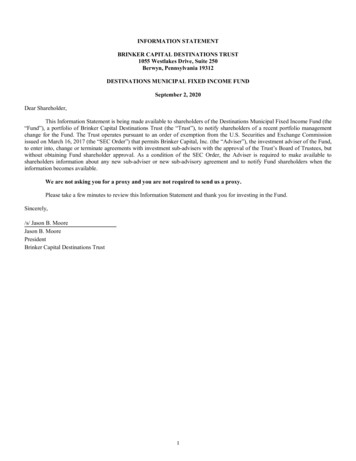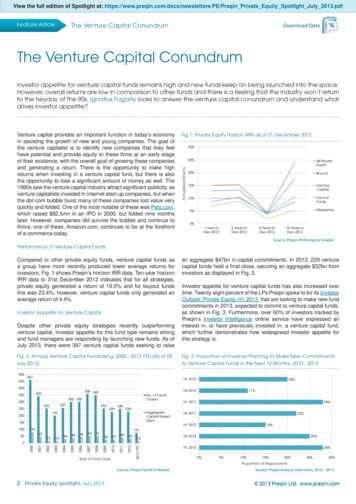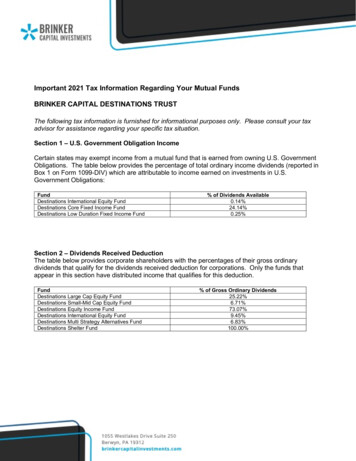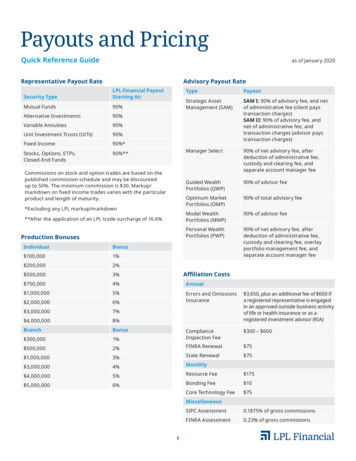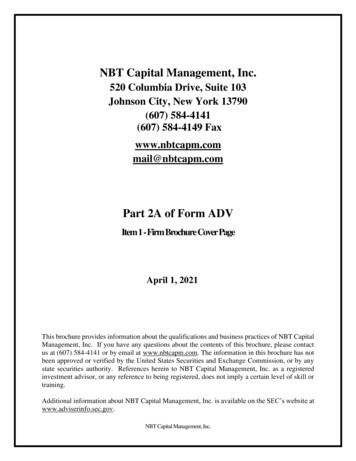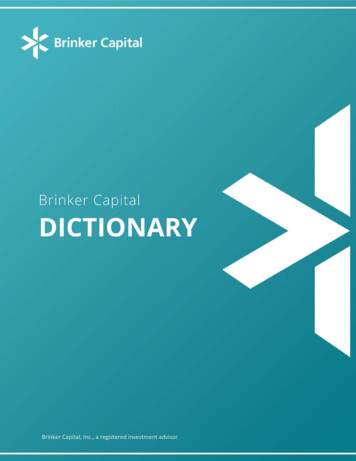
Transcription
Brinker Capital, Inc., a registered investment advisor
AAbsolute return: Investment strategies that seek to deliver a positive rate of return regardless ofbroad economic and market conditions. These niche offerings tend to be uncorrelated with – ormove independent of – major asset classes, such as stocks and bonds.Automated Customer Account Transfer Service (ACAT): A system that facilitates the transfer ofsecurities from one trading account to another at a different brokerage firm or bank. It wasdeveloped by the National Securities Clearing Corporation (NSCC) to replace the previous manualasset transfer system.Advisor Council: An annual event during which Brinker Capital hosts its top financial advisors inPhiladelphia for two days of networking, entertaining, and presentations on the economy, markets,Brinker Capital investment solutions, and corporate initiatives, among other topics.Asset allocation: An approach to investing that seeks to balance risk and reward by allocating capitalacross a portfolio of major and minor asset classes.Asset class: A grouping of similar types of investments such as domestic equity, international equity,fixed income, global credit, absolute return, and real assets.Asset Movement Authorization (AMA): At Fidelity only, advisors/reps have the ability to have theclient give different levels of authorization to act on their behalf.Attestation form: Third-party attestation form that an advisor/rep signs indemnifying BrinkerCapital of money not going to the client.Automated Clearing House (ACH): An electronic fund-transfer system.BBear market: A general decline in the stock market over a period of time. While there's no agreedupon definition of a bear market, one generally accepted measure is a price decline of 20% or moreover at least a two-month period.Benchmark: An index against which the performance of a security, mutual fund, portfolio, orinvestment manager can be measured.Bond: A debt security issued by national governments, municipalities, and public and privatecompanies, among other entities, as a means of raising funds. The entity that issues the bond isknown as the issuer and the individual or institution that purchases the bond is known as thecreditor. Most bonds pay periodic interest (or coupon) payments at a fixed rate and also promisethe return of the creditor’s principal (the purchase price or face value of the bond) at maturity(when the bond is retired). Most bonds are issued with a face value of 100 or 1,000 and mostmake their coupon payments on a semi-annual basis.2For internal use only
Broker-dealer (b-d): A person or firm in the business of buying and selling securities for its ownaccount or on behalf of its customers. The term broker-dealer is used to describe stock brokeragesbecause most of them act as both agents and principals. A brokerage acts as a broker (or agent)when it executes orders on behalf of its clients, whereas it acts as a dealer, or principal, when ittrades for its own account. Most advisors/reps working with Brinker Capital are employed by eithera broker-dealer or an RIA (Registered Investment Advisor).Bull market: Refers to any financial asset (stocks, bonds, commodities, etc.) where prices are rising,usually for months or years. Most market participants believe a bull market begins when anyfinancial asset has risen 20% in value, after declining 20% or more. The bull market remains in placeuntil the asset class in question declines 20% and enters its next bear market.CCapital: Assets, including cash, held by an individual, company, or nation that are available forinvestment.Capital appreciation: A rise in the value of any asset, such as a stock, bond, or real estate. From aninvesting perspective, funds can be managed with an eye toward generating capital appreciation bypurchasing equities that are most likely to rise in value over time (as opposed to funds that aremanaged with an eye toward generating income).Central Registration Depository (CRD): A database maintained by FINRA for all firms and individualsinvolved in the US securities industry. It is used to store and maintain information on registeredsecurities and broker firms, as well as individuals who dispense investing and financial advice. Everyfinancial advisor has a unique CRD number.Client: A person or organization using Brinker Capital’s services. This could be the end investorand/or the financial advisor.Collateral: Property or other assets that a borrower offers a lender to secure a loan. Typically, if theborrower defaults on the loan (can’t make principal and/or interest payments) the lender can seizethe collateral to recoup any losses.Core Asset Manager: A managed account solution offering a variety of ways to invest using thirdparty investment strategies including separately managed accounts, mutual funds, ETFs, and limitedpartnerships. Client portfolios can be either customized using third party investment strategies(Core Select) or invested in Core Guided, a range of risk-based, tax-managed, or income-focusedportfolios.Custodian: A bank or brokerage firm where assets are held on behalf of a client. Brinker Capital usesFidelity and National Financial Services as custodians for client accounts.For internal use only.3
DDestinations: A series of dynamic, multi-asset class, risk-based discretionary portfolios. Destinationsportfolios are comprised from a series of ten proprietary mutual funds (“Destinations Funds”)constructed using third-party manager investment strategies.Destinations ETFh: A series of dynamic, multi-asset class, risk-based portfolios comprised of a hybridmix of passive ETFs and active third-party mutual funds.Discretionary portfolio: An arrangement in which an investment manager (Brinker Capital) makesthe buy and sell decisions without consulting with the end client for each transaction.Diversification: The practice of combining assets and types of assets with different characteristics ina portfolio for the purpose of reducing risk.Dollar Cost Averaging (DCA): An investment strategy that allows an investor to buy the same dollaramount of an investment a regular intervals. The purchase occurs regardless of the price of theasset. The most common example of dollar cost averaging is its use within 401(k) plans (e.g. the401(k) plan participant allocates the same amount of money each pay period). DCA is one wayinvestors can manage short-term volatility – by putting a fixed dollar amount to work on a regularbasis focused on accumulating assets instead of worrying about market fluctuations or drawdowns.Dollar Value Average (DVA): An additional service available within Destinations that invests theclient’s assets gradually over a period of time instead of all at once.Domestic equity: US or domestic stocks which represent ownership in large, medium, or smallcompanies offering varying levels of growth or income via dividends.Due diligence: The process of conducting research and analysis on investment strategies thatBrinker Capital currently engages with or would like to engage with. The process focuses on the fiveP’s: people, philosophy, process, performance, and parent organization. This continuous process istime and resource intensive and is part of Brinker Capital’s value proposition.EEarnings: A company’s after-tax net income. Earnings are particularly important to a publicly-tradedcompany’s share price as they help investors determine the level of profitability, the growth inprofitability, the consistency of profitability, and the appropriate price-to-earnings (P/E) ratio for thecompany’s stock (all things being equal, companies that grow their earnings at an above-averagepace will command a higher P/E ratio).Exchange-Traded Fund (ETF): A marketable security (trades on a stock exchange) that tracks theperformance of underlying financial assets, including a stock index, bonds, or commodities. Whilesimilar to a mutual fund, ETFs can be bought and sold intra-day, (reflecting intra-day pricing)whereas mutual funds can only be bought and sold after the market closes (reflecting market closepricing).4For internal use only
Equity: A form of capital. Companies will issue equity, via shares of stock, in their company inexchange for cash, which will most likely be invested to further grow the company. Holders ofequity have a claim on the company’s profits and, over time, should see the value of their equityincrease in-line with the company’s earnings. Risks to owning equity include dilution (the companyissues more shares of stock) and a decline in the value of the equity.FFiduciary: An individual who holds a legal or ethical relationship of trust with one or more parties.Typically, a fiduciary prudently takes care of money or other assets for another person or group ofpeople.Financial advisor (FA): A financial adviser or (also referred to as an advisor or rep) is a professionalwho suggests and renders financial services to clients based on their financial situation. This is theindividual who Brinker Capital works with regarding end-client relationships.Financial Industry Regulatory Authority, Inc. (FINRA): A private corporation that acts as a selfregulatory organization. FINRA is the successor to the National Association of Securities Dealers, Inc.(NASD) and the member regulation, enforcement, and arbitration operations of the New York StockExchange. It is a non-governmental organization that regulates member brokerage firms andexchange markets. Brinker Capital Securities, Inc. (our broker-dealer) is regulated by FINRA, whichalso oversees all securities licensing procedures and requirements for broker-dealers. Examples ofsome FINRA licenses, Series 6, Series 7, Series 24, Series 63, Series 65, and Series 66.Fixed income: A type of investment in which the borrower or issuer is required to make payments ofa fixed amount on a fixed schedule. Bonds are the most common form of fixed income investment.Form ADV: A uniform form used by investment advisors to register with both the SEC and statesecurities authorities. There are two parts: Part 1 requires information about the investmentadvisor’s business, ownership, clients, employees, business practices, affiliations, and anydisciplinary events of the advisor/employees. Part 2 requires investment advisors to have brochureswritten in plain English that contain information such as the types of advisory services offered, feeschedule, disciplinary information, conflicts of interest, and education and business background ofmanagement and key personnel.For internal use only.5
GGlobal credit: Consists of debt obligations issued by US corporations, non-US corporations, and nonUS sovereign issuers (i.e. governments outside the US). Global credit securities provide an attractivediversification benefit to portfolios as they have a lower correlation to traditional fixed incomesectors. Global credit securities also offer a higher income component than US governmentsecurities as they are subject to additional risks such as credit risk and liquidity risk. Types of globalcredit securities include US high-yield, non-US fixed income, and emerging market debt.Gross fees: Investment returns that are reported before fees are taken out.HHouse holding: The grouping of multiple client accounts in ProGen and Brinker Capital’s websitethat shows and measures the performance of all the client’s assets on a single page.IIncome: Cash or cash equivalents received from capital invested that could be in the form ofinterest, dividends, or realized gains.Insurance: A means of protection from financial loss. More specifically, insurance is a contract,represented by a policy, in which an individual or entity receives financial protection orreimbursement against losses from an insurance company. The insurance policy will stipulate thecost of the financial protection (known as the premium), the deductible (the amount that thepurchaser of the policy must pay out of pocket before the insurer pays a claim), and the policy limit(the maximum amount an insurer will pay under a policy for a covered loss). The most commontypes of personal insurance policies are auto, health, homeowners, and life.Interest: Payment from a borrower or deposit-taking financial institution to a lender or depositor ofan amount above repayment of the principal sum (i.e., the amount borrowed), at a particular rate.The rate of interest associated with borrowed money will vary and is typically determined by thecreditworthiness of the borrower, the amount of money borrowed, and the length of time for whichit has been borrowed.Interested party: A person authorized by the client to access the client’s account. This is often anaccountant or tax preparer.6For internal use only
International equity: Foreign stocks, or stocks of companies domiciled outside the US. Internationalequity can be divided into developed markets and emerging markets. Developed markets includemature economies,liquid, and well-established capital markets (i.e. France or Japan). Emergingmarkets consists of still-developing economies and capital markets (i.e. Brazil and India). Whilecompanies in emerging economies tend to be growing faster than companies in developedeconomies, both fundamental performance and respective share prices tend to be more volatile.Investor: An individual or an entity that commits capital with an expectation of a future financialreturn (i.e. profit, income, or both). Investors utilize investments (such as stocks and bonds) with aneye toward growing their existing capital to better enable them to meet future liabilities.Investment management: The professional asset management of various securities and other assets(i.e. the buying and selling of securities within a portfolio) in order to meet specified investmentgoals for the benefit of the investor.Irrevocable trust: A trust that generally cannot be revoked or amended at any time onceestablished.Individual Retirement Account (IRA): An investment vehicle allowing an individual to save forretirement on a tax-deferred basis. While there are several types of IRAs and restrictions on theamount of money that can be invested and when money can be withdrawn, the most compellingfeature of an IRA is that as the capital is invested and grows, the owner of the IRA doesn’t have topay taxes on realized gains, dividends, or income received.Investment Advisory Agreement (IAA): The contract between Brinker Capital, the client, andfinancial advisor required to open a new Brinker Capital account.JJoint Tenants in Common (JTIC): A type of brokerage account that is owned by at least two peoplewith no rights of survivorship afforded to any of the account holders. A surviving tenant of a jointtenants in common account does not necessarily acquire the rights (and account assets) of thedeceased person. Each tenant in the account can stipulate in a written will how their assets will bedistributed upon their death.Joint Tenants in Entirety (JTIE): A type of brokerage account owned by a husband and wife in whicheach party has the right of survivorship over the property and which neither party can terminatewithout the consent of the other.Joint tenants with Rights of Survivorship (JTWROS): A type of brokerage account owned by at leasttwo people, where all tenants have an equal right to the account's assets and are affordedsurvivorship rights in the event of the death of another account holder.For internal use only.7
LLetter of Acceptance (LOA): Used when a client is transferring from a qualified plan into an IRALetter of Instruction (LOI): List of relevant financial information including banking accounts,individual retirement accounts, and taxable investment accounts for a partner, attorney, orexecutor.Letter of Understanding (LOU): Also known as a selling agreement, a mutual agreement betweenBrinker Capital, Inc. and RIA/b-d firms that outlines the provisions of the investment advisoryservices provided to clients.MMacro view: A general, high-level view of an asset class, market, or economy. More specifically, aview of the direction of the global economy and global politics and how they might impact riskassets and influence portfolio management decisions considering factors such as inflation, economicgrowth, unemployment, interest rates, and exchange rates.Manager selection: The process of choosing a manager for inclusion within an investment portfolio.Factors that may be considered in the selection process are performance (absolute, relative tobenchmark, relative to peers), fees, assets under management, and manager tenure. Managerselection is one of the ways in which Brinker Capital adds value to its investors.Moderate portfolio: A portfolio with a neutral allocation that is generally comprised of 60% equitiesand 40% fixed income.Model: A non-custom asset allocation that is the same for all clients. For example, DestinationsModerate is one of the Destinations models.Multi-asset class: An allocation to a combination of asset classes used as an investment. This is theinvestment philosophy that Brinker Capital follows.Mutual fund: A company that pools money from many clients and invests the money in financialassets, such as stocks or bonds. The investors own shares of the fund, which represent a portion ofits holdings, and those holdings of the mutual fund are known as its portfolio. There are bothactively managed mutual funds – where professional investors determine what securities to buy andsell – and passively managed mutual funds – which tend to simply replicate the holdings of a stockor bond index, such as the S&P 500 Index.8For internal use only
NNet fees: Returns that are reported after fees have been subtracted.New Account Paperwork (NAP): The paperwork required to open an account at Brinker Capital. Itincludes the IAA (Investment Advisory Agreement) and custodial new account paperwork.Not in good order (NIGO): Applications that are incomplete, inaccurate, ambiguous, or conditional.The errors must be resolved before the document can be processed.Outsourced investment management: Delegating a significant portion of the investment officefunction to a third-party provider, typically an investment management firm.PP/E ratio: The P/E ratio (price-to-earnings ratio) is the valuation ratio of a company's market valueper share divided by a company's earnings per share (EPS).Payout: The commission money Brinker Capital pays to advisors.Personalized Distribution Strategy (PDS): A customized withdrawal strategy and cash reservemanagement solution, available within Destinations portfolios, that helps provides for a clientsfuture spending needs.Periodic Investment Plan (PIP): Client periodically adds money to their investment in an automatedfashion.Platform manager: Individuals responsible for overseeing the development of the platform that isused by those working for the company and/or the platform of customers who do business with thecompany.Portfolio: A grouping of financial assets, which could include stocks, bonds, or a combination of thetwo. Portfolios can also be comprised of broader investment strategies, including actively managedmutual funds, index funds, or exchange-traded funds(ETFs).Portfolio manager (PM): The individual who oversees a portfolio of financial assets. This portfoliocould hold individual securities, such as stocks and bonds, or broader investment strategies,including actively managed mutual funds, index funds and exchange-traded funds(ETFs), separatelymanaged accounts, limited partnerships, etc.Power of Attorney (POA): The authority to act for another person in specified or all legal or financialmatters. NFS/Fidelity forms plus the client’s own documentation.For internal use only.9
Principal: The original sum of money borrowed in a loan or put into an investment. In the context ofan investment, if you put 50,000 into a Destinations account and the value grows to 100,000, theoriginal 50,000 is the principal and the additional 50,000 is capital appreciation.Proposal Generation System (ProGen): The system that Brinker Capital uses to create proposals foradvisors to present to potential clients.RReal assets: Assets that have value due to their substance and properties. May include tangibleassets such as real estate, precious metals, and commodities or financial assets such as stocks,bonds, and mutual funds.Realized gains: Increases in the value of an asset that has been sold.Rebalance (RB)/reallocation: The action/trading strategy of bringing a portfolio that has deviatedaway from one's target asset allocation back in-line. This can be implemented by transferring assetsor selling investments of an asset class that is overweight and using the proceeds to buy investmentsin a class that is underweight.Registration change (RC): The act of changing an existing account from one type to another. Forexample, changing a joint account with two owners to a single account with one owner.Relationship manager: The primary and/or initial service contact at a company.Request for proposal (RFP): Document that solicits a proposal by an agency or company interestedin the procurement of a commodity or service to potential suppliers to submit business proposals.Retirement Plan Services (RPS): Brinker Capital’s 401(k) offering invested in Destinations portfolios.Revocable Trust: A trust whereby provisions can be altered or canceled dependent on the grantor.This type of agreement provides flexibility and income to the living grantor; he/she is able to adjustthe provisions of the trust and earn income, with the knowledge that the estate will be transferredupon death.Risk analysis: The identification, evaluation, and prioritization of risks to manage the probability orimpact of unfortunate events or to maximize the realization of opportunities.Risk asset: Any asset that carries risk. The term generally refers to any financial security orinstrument, such as equities and commodities, that have a significant degree of price volatility andthe risk of financial loss. High-quality sovereign bonds, such as US Treasuries, are not consideredrisk assets as principal and interest are backed by the full faith and credit of the issuing government.Risk-averse: A characteristic of avoiding investment risk. The characteristic is usually associatedwith investors who prefer investments with lower returns and relatively known or understood risksover investments with potentially higher returns but with greater uncertainty or more risk.10For internal use only
Return on investment (ROI): A way to measure what an individual or company generated in netprofit for the amount of capital invested.Registered Investment Advisor (RIA): A person or firm who advises individuals on investments andmanages their portfolios. RIAs serve as a fiduciary to their client.SSalesforce: The cloud-based customer relationship management (CRM) system that Brinker Capitaluses. This also integrates with many other systems that Brinker Capital utilizes.Securities and Exchange Commission (SEC): The government agency that acts as the ultimateregulator of the securities industry, including FINRA. The mission of the US Securities and ExchangeCommission is to protect investors, maintain fair, orderly and efficient markets, and facilitate capitalformation. Brinker Capital is regulated by the SEC.Seismic: Marketing enablement software that provides employees with access to marketingmaterials.Separately managed account (SMA): A portfolio of securities managed by a professional investmentfirm, providing direct ownership of the underlying positions in the portfolio.Sharpe ratio: Developed by Nobel Laureate William F. Sharpe and is used to help investorsunderstand the return of an investment compared to its risk. The ratio is the average return earnedin excess of the risk-free rate per unit of volatility or total risk. The higher the Sharpe ratio, thebetter the fund’s historical risk-adjusted performance.Short selling: An investment or trading strategy that bets on a decline in a security's price. Aninvestor or trader seller opens a position by borrowing shares of a stock or other asset, andthen selling them.Standing Instructions (SI): Either check, ACH, or wire instructions that a client signs to add to theirinvestment account.Stock: Also known as shares or equity, a type of security or financial asset that signifies bothownership in a company and a claim on part of that company’s assets and earnings. Owning acompany’s common stock (there are different types of stock or shares) usually entitles the owner toboth vote at the company’s shareholders’ meeting and to receive dividends.Systematic withdrawal plan (SWP): Client periodically withdrawals money from their investment inan automated fashion.For internal use only.11
TTAMP (Turnkey asset manager program): A fee-account technology program that financial advisors,broker-dealers, insurance companies, and banks can use to oversee their clients’ investmentaccounts.The Center for Outcomes: Brings together experts in education, behavioral finance, business,investments, sales, and communication to provide education that strengthens the advisor-clientrelationship through conversations centered around outcomes. The Center for Outcomes Model is arepeatable communication model that enables advisors to save time, improve productivity, increaseclient retention, and enhance their reputation in the investor marketplace. The Center for Outcomesis powered by Brinker Capital.Trust Certification of Investment Powers (TCIP): NFS form allowing one trustee to act individually ifthere is more than one trustee on an account.Transfer of Assets (TOA): Initial or subsequent funding to a client’s investment.Trust: A fiduciary relationship in which one party, known as a trustor, gives another party, thetrustee, the right to hold title to property or assets for the benefit of a third-party, the beneficiary.Trustee: A person or firm that holds and administers property or assets for the benefit of a thirdparty.VValuation: The analytical process of determining the current (or projected) worth of an asset or acompany.Value-add activities: Activities that add value to the final product. For example, individuals can addvalue to the services they perform, such as sharing their advanced skills with clients.Volatility: A statistical measure of the dispersion of returns (range of price change) for a givensecurity or market index over a given period. In most cases, the higher the volatility, the riskier thesecurity or index.WWealth Advisory: Brinker Capital’s customizable investment solution and services for high net worthand institutional investors with greater than 1 million of investable assets.Withdrawal: Removing funds from a bank account, savings plan, pension, or trust.12For internal use only
For internal use only.13
14For internal use only
An annual event during which Brinker Capital hosts its top financial advisors in Philadelphia for two days of networking, entertaining, and presentations on the economy, markets, Brinker Capital investment solutions , and corporate initiatives, among other topics.

